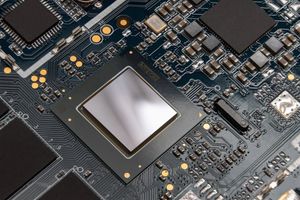3 Technologies to Challenge NAND Flash Dominance in AI

Artificial intelligence (AI) applications and platforms are growing like weeds. The arms race for AI superiority continues to be waged between the chip makers trying to chip away at Nvidia Co. (NASDAQ: NVDA) dominance in the GPU segment to Micron Technology Inc. (NASDAQ: MU) NAND flash memory dominance in memory chips for data storage. The computer and technology sector is always evolving, and today’s winners can be yesterday’s losers in a flash, no pun intended. Here are 3 upcoming disruptive technologies to challenge NAND flash memory dominance in AI.
Magnetoresistive RAM (MRAM)
[content-module:CompanyOverview|NASDAQ: MRAM]
This memory technology is non-volatile (doesn’t lose data when power is shut off), has high radiation resistance, and can be operated in extreme temperature conditions. It’s sometimes referred to as Spin-Transfer Torque Magnetoresistive RAM (STT-MRAM). It utilizes magnetic tunnel junctions (MTJs) to store data by manipulating the electron spins.
This results in extremely fast read/write speeds with higher endurance than NAND. It's a combination of storage density coupled with SRAM speed, power efficiency, and non-volatile features. The downside is that the storage density is low, and manufacturing costs are high. In addition to AI applications, it is also ideal for automotive, military and industrial applications due to its ability to operate in extreme temperatures and tamper-resistant nature.
While MRAM has yet to reach its potential, Everspin Technologies Inc. (NASDAQ: MRAM) is considered the leader in the segment. They’ve partnered with GLOBAL FOUNDRIES Inc. (NASDAQ: GFS) to integrate MRAM into 22FDX technology.
Phase-Change Memory (PCM)
[content-module:CompanyOverview|NYSE: IBM]
This non-volatile technology stores data by switching material between amorphous and crystalline states on a nano level. The stored data can be retained and stored for 10 years at room temperature. It's as fast as a DRAM. It has lower power consumption than NAND. However, it has lower storage density and can suffer from resistance drift, where the amorphous state drifts more than the crystalline state. International Business Machines (NYSE: IBM) is working to progress the technology integrating PCM-based cores with its digital computing processors.
3D XPoint Memory (3DXP)
[content-module:CompanyOverview|NASDAQ: INTC]
This type of storage memory is being developed by Intel Co. (NASDAQ: INTC) and Micron Technology. It utilizes a 3D crossbar with resistance-switching materials. Intel's Optane SSDs use 3D XPoint technology which is significantly faster than NAND flash memory in access and transfer times.
The speed advantage comes from addressing single cells rather than whole blocks to perform write operations rather than having to perform a whole sequence of read-modify-write operations. The technology has very low latency and simultaneous read and write operations with very high endurance with performance degradation. 3D XPoint bridged the gap between NAND and RAM. Unfortunately, it wasn’t enough.
The technology had limited availability, adoption and high costs. Intel has announced the discontinuation of its Optane SSD DC P4800X drives. Despite being superior to NAND, it had limited market adoption as the chips were just not competitive with NAND on price and having an established infrastructure. Intel resumed its focus on developing its core processor business.
It's Hard to Knock The King Off the Mountain
3D XPoint can be a cautionary tale of a superior technology that couldn't get major adoption due to NAND Flash's high costs and incumbent dominance. Companies are unlikely to stray from an established infrastructure when something is the standard. The challengers will keep coming, but the moat is wide and deep for NAND as it is the standard, and companies are hesitant to stray from the standard in any technology.
More News
View More




Recent Quotes
View More
Quotes delayed at least 20 minutes.
By accessing this page, you agree to the Privacy Policy and Terms Of Service.